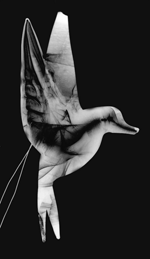I take clippings of plants into the darkroom with me. In total darkness (there is no safe light in the color darkroom), I arrange them, by feel. I then expose the plants to different colors and intensities of light. The shadows the plants cast on the paper create the images and the light that filters through the plants determines the colors. Once the exposure is done, I remove the plants and put the paper through color chemistry baths to reveal the image. Only when the paper has been developed and fixed can I turn on the lights and see what I’ve created. If the image is too dark or the composition is not good, then the image is destroyed and the process starts over.
Click on the above image to see the step-by-step explanation of my process.
There is a lot of testing, trial and error, and editing that happens in the darkroom. While it only takes between 5 and 30 seconds to expose a single sheet of paper, plus a few minutes to develop the image and make it light safe… it can take several hours or all day to create a piece that I want to show the world.
What is a Photogram?
Photograms have also been called Sun prints, Shadowgrams, and Rayograms (after Man Ray), but regardless of the name, the process is the same. It is a photographic process that captures the shadow of an object. Because photo paper is light sensitive, the parts of the paper that get lots of light turn dark and the parts that didn’t get light stay white. The resulting image is a negative silhouette.
 For example, if you put an object like a metal camel key chain (no light can get through it) on the paper and shine a light on it, you get a simple silhouette of the camel key chain.
For example, if you put an object like a metal camel key chain (no light can get through it) on the paper and shine a light on it, you get a simple silhouette of the camel key chain.
 But when the object is see-through, like a glass hummingbird, then the light shines through the object and createsan x-ray like effect, showing the outline of the humming bird but also some of the details inside. I think the images are more interesting when made using more transparent objects so you can see the texture inside.
But when the object is see-through, like a glass hummingbird, then the light shines through the object and createsan x-ray like effect, showing the outline of the humming bird but also some of the details inside. I think the images are more interesting when made using more transparent objects so you can see the texture inside.
Photograms are made one at a time by placing objects on light sensitive paper and exposing them to light. Every time you place the object on the paper, you get a different composition so every photogram is an original piece of work. In color photograms the color of the light and the color of the object also changes each time and combines to create uniquely bold and beautiful images.
Did you invent this process?
I wish I could claim that I did! While my color photograms are certainly a modern/updated version, photograms date back to the early 1800s. When photo chemistry was being invented it was often tested by painting the latest solution on paper, putting a leaf on it, and laying it out in the sun. Hence the name “Sun Prints”. When a light sensitive solution was found it became clear that the resulting image was a negative since there was a void where the plant had been, and everything else was dark. Once the chemistry was improved to include a “fix” process so the images were permanent, this became the basis for negatives used in cameras as well as cyanotypes and blueprints. Photography was born with the help of Photograms. One of the things I love the most about this process is that after 200+ years, the darkroom is still full of surprises.
